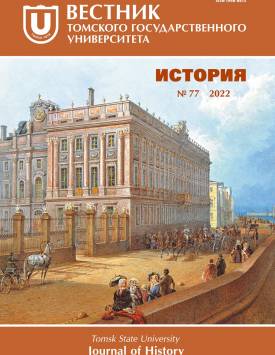Figurative and symbolic specifics of the Representation of the Entente and the United States in the Soviet Printed Propaganda of the Civil War Period (1918-1920)
The aim of this work is to reconstruct the content and define key characteristics and methods of forming the image of an external enemy in the Soviet agitation and propaganda materials during the Civil War (from January 1918 to January 1920). A typology of images is carried out, with the help of which the new government formed ideas about an external enemy, based on a quantitative and qualitative analysis of the content of newspaper publications and poster plots. The analysis of the image of the interventionists as a "hostile Other", which was formed on the pages of the press and with the help of poster graphics, has made it possible to characterize the methods and techniques, as well as the values of the Soviet propaganda in this period. The methods of forming the image of an external enemy at the textual and figurative-symbolic level did not always have clear boundaries of application, often mixing up within the same message / text - a poster or a newspaper article. Visual images and symbols of various types could be present within the same plot. Mocking and revealing couplets were combined with invocative slogans. A look at the “hostile Other” through the class optics did not exclude the use of a metaphorical language of description, which included zoomorphic images and stereotypical ideas about one or another former allied power. The combination of socio-political and national-symbolic stereotyping, coupled with the using of language and visual techniques for the purpose of dehumanization and ridiculing, made it possible to form a multidimensional image of the enemy. On the one hand, it was the personification and bearer of a system of exploitation and oppression that was hostile to the new Soviet regime. At the same time, it was firmly connected with the internal opponents of the Bolsheviks at the class level. On the other hand, the image was both monolithic (bourgeois states/governments, capitalists / imperialists) and fragmented (individual countries, politicians, governments, interventionist troops). The ambivalence of the hostile image of the interventionists was achieved by using a set of recognizable and easily perceived characteristics. They were based on familiar and replicated language and visual components, as well as on developed, unified and reproducible message-to-message confrontation schemes that were based on class-specific perception of the current conflict. One could imagine a kind of narrative "about the construction of a new world". The main positive characters of this narrative were the Bolsheviks themselves, the world and Russian proletariat. The former allies were seen as a part of the world imperialist system. No distinction was made between internal and external "counter-revolution". At the same time, the variability of approaches and formats demonstrates a wide range of political metaphors, some of which were dictated not only by the doctrinal principles of the Bolsheviks, but also by a set of archetypal ideas based on deeper mental codes The authors declare no conflicts of interests.
Keywords
the Civil War in Russia, the Bolsheviks, visual propaganda, periodicals, the image of the enemyAuthors
| Name | Organization | |
| Konev Kirill A. | Tomsk State University | konev-k-92@rambler.ru |
| Fedosov Egor A. | Tomsk State University | e.a.fedosov@yandex.ru |
References

Figurative and symbolic specifics of the Representation of the Entente and the United States in the Soviet Printed Propaganda of the Civil War Period (1918-1920) | Tomsk State University Journal of History. 2022. № 77. DOI: 10.17223/19988613/77/3
